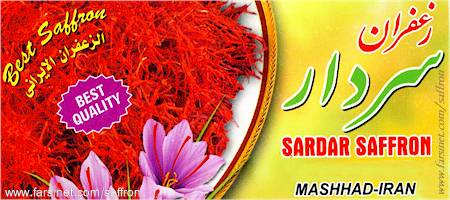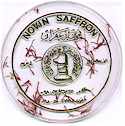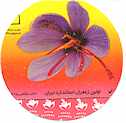
|  |
|---|
| ||||||||||||||||||
| Saffron - Flower of Health - Its origion and its uses | |
|---|---|
| English | Persina (Farsi) |

| |||
|---|---|---|---|

| |||

| 
| ||
| Novin Saffron Mashhad, Iran | Fisrt Standard Quality Saffron For Export from Mashhad, Iran | ||
| Click on an image above for contact information | |||
'The use of it ought to be moderate and reasonable, for when the dose is too large, it produces a heaviness of the head and sleepiness. Some have fallen into an immoderate convulsive laughter which ended in death.'
Culpeper's The Complete Herbal, 1649
 Saffron Threads vs. Powdered Saffron
Saffron Threads vs. Powdered Saffron
Saffron has an aroma and flavor which cannot be duplicated, and a chemical make-up
which, when understood, helps the chef or home cook to know how to best
release that flavor and aroma in cooking and baking. Saffron is sold in
two forms, powder and threads, and each behave very differently in the
kitchen.
In order to understand commercial saffron, it is important to understand the make-up of the saffron plant. More importantly, it is the easiest way for you, as a consumer, to be sure you are buying good saffron. Commercial saffron comes from the bright red stigmas of the saffron crocus (Crocus sativus) which flowers in the Fall in many different countries, including Greece, India, Iran and Spain. The Crocus sativus stigmas are the female part of the flower. In a good year, each saffron crocus plant might produce several flowers. Each flower contains three stigmas, which are the only part of the saffron crocus that when dried (cured) properly, become commercial saffron. Each red stigma is like a little capsule that encloses the complex chemicals that make up saffron's aroma, flavor, and yellow dye. In order to release these chemicals, you must steep the threads. Powdered saffron is more efficient because it does not need to be steeped.
 Saffron Links:
Saffron Links:
- Iran Saffron - Quality grading, Pricing, Packing, etc.

- Saffron - An Ancient Spice
- Saffron Glossary - American Saffron, Saffron coloring strength, Extracting/Steeping Saffron, ...
- www.saffron.name
 Saffron Recipes:
Saffron Recipes:
- Saffron Steamed Rice
- Tah-Chin - Saffron Rice Chicken
- Special Scalloped Potatoes
- Parsnip Lemon Puree
- Orange Saffron Butter Cookies
- More Persian Recipes
Saffron Steamed Rice
Ingredients: (6 servings)
- 3 cups long-grain basmati rice
- 8 cups water
- 2 tablespoons salt
- 2 tablespoons plain yogurt
- 1 teaspoon ground saffron dissolved in 4 tablespoons hot water
- 3/4 cup butter or olive oil or ghee
Directions:
- Pick over the rice. Basmati rice like any other old rice contains many small solid particles. This grit must be removed by picking over the rice carefully by hand.
- Wash the rice by placing it in a large container and covering it with lukewarm water. Agitate gently with your hand, then pour off the water. Repeat five times until the rice is completely clean. When washed rice is cooked it gives off a delightful perfume that unwashed rice does not have. If using long-grain American or Texmati rice, it is not necessary to soak or wash five times. Once will suffice.
- After washing the rice it is then desirable but not essential to soak it in 8 cups of water with 2 tablespoons of salt for 2 to 24 hours. Soaking and cooking rice in a lot of salt firms it up to support the long cooking time and prevents the rice from breaking up. The grains swell individually without sticking together. The result is light and fluffy rice known as the Pearls of Persian Cuisine.
- Bring 8 cups of water with 2 tablespoons salt to a boil in a large non-stick pot. Pour the washed and drained rice into the pot. Boil briskly for 6 to 10 minutes, gently stirring twice with a wooden spoon to loosen any grains that may have stuck to the bottom. Bite a few grains. If the rice feels soft, it is ready. Drain rice in a large, fine-mesh colander and rinse in 2 or 3 cups of lukewarm water.
- In a bowl, mix 2 spatulas of rice, the yogurt, 1/2 cup butter or oil and 1/2 cup hot water, and a few drops of dissolved saffron water.
- In the pot, spread the yogurt-rice mixture over the bottom of the pot. This will help to create a tender golden crust (tah dig) when rice is cooked.
- Take one spatula full of drained rice at a time and gently place it on top of the yogurt and rice mixture, gradually shaping the rice into a pyramid. This shape leaves room for the rice to expand and enlarge. Poke one or two holes in the rice pyramid with the handle of a wooden spatula.
- Cover and cook rice for 10-15 minutes over medium heat in order to form a golden crust.
- Dissolve the remaining butter in 1 cup hot water and pour over the rice pyramid. Place a clean dish towel or 2 layers of paper towels over the pot and cover firmly with the lid to prevent steam from escaping. Cook for 40-50 minutes longer over low heat.
- Remove the pot from heat. Allow to cool on a damp surface for 5 minutes without uncovering it. This helps to free the crust from the bottom of the pot. Then put 2 tablespoons of rice in a dish, mix with remaining saffron water, and set aside for garnish.
- Gently taking one spatula full of rice at a time, place it on a serving platter without disturbing the crust. Mound the rice into a cone. Sprinkle the saffron rice garnish over the top.
- Detach the layer of crust from the bottom using a wooden spatula. Place into a small platter and serve on the side or arrange it around the rice.
Tah-Chin - Saffron Rice Chicken Dish
Ingredients: (4 servings)
- chicken, 1 kg
- basmati or long grain rice, 500 grams
- yogurt (Greek if possible), 300 grams
- saffron, 1/2 teaspoon
- large onions, two
- 3 eggs (yolks only)
- cooking oil
- salt
- black pepper
Directions:
Start by washing rice and soaking it in warm water (with added salt) for 2 hours. Then filter out the water.
Chop onions into thin slices and fry in oil until slightly golden. Wash and cut chicken, remove skin, and fry in onions until color changes. Add some water and bring to boil. Turn heat down and let boil slowly until cooked, adding more water if needed. Remove the bones.
While chicken is cooking, beat the yogurt until it is smooth. Dissolve saffron in half a cup of hot water. Add saffron, salt, pepper and egg-yolks to the yogurt and mix very well.
Pour a few glasses of water in a large pot and bring to boil. Pour in rice and cook while stirring occasionally until rice grows longer and slightly softens (Take care not to overcook the rice. It should still be too hard for eating). Again filter out the water.
Pour several spoons of oil and several spoons of the yogurt mix into a non-stick pot. Add a thin layer of rice and flatten using the back of a spoon. Add a layer of chicken on top followed by another layer of rice. Again flatten the rice. Spread several more spoons of the yogurt mix on the rice. Continue in this fashion until chicken, rice and the yogurt mix have been used up. Add some more oil on top. Put the lid on and cook for about 5 minutes over medium heat.
Place the pot in an oven (preheated to 250 F) and cook for 1.5 to 2 hours. Note that the longer Tah-Chin is cooked, the thicker the Tah-Dig (delicious crispy layer of rice at the bottom) will be. When cooked, remove the lid and let cool for a few minutes.
Place an inverted large dish over the pot and turn it over. Tap the pot in order to loosen the contents inside. The contents should fall on the dish in one piece with the Tah-Dig on the outside.
Saffron Scalloped Potatoes
Ingredients: (4 servings)
1 pinch (.125 g) saffron threads1 1/4 cups half & half
3 Tbsp. butter
1 Tbsp. virgin olive oil
2 Large yellow onions, sliced thin
2 garlic cloves, minced
4 large white potatoes, sliced thin
Directions
Heat half & half, remove from heat and steep saffron for 20 min. Saute and garlic until limp in olive oil and butter. Do not brown. Butter large pie plate and layer with potato and onion slices. Pour half & half over the top and bake at 350:(175: C), covered with tin foil, for an hour. Remove foil and bake an additional 15 min. or until top is browned. Serve in wedges. Serves 4.Saffron Parsnip Lemon Puree
Ingredients:
1 pinch (.125 g) saffron threads2 tsp. lemon juice
4 parsnips, peeled & cubed
2 Tbsp. butter
1/2 cup half & half
Directions
Add saffron to lemon juice. Cover parsnips with water in sauce pan and cook until tender. Drain parsnips and combine with remaining ingredients in the bowl of a food processor. Blend until smooth, scraping down sides if necessary. Serve immediately.Orange Saffron Butter Cookies
Ingredients:
1 1/8 cups of flour1 stick of butter
2 pinches saffron threads(.250 gr)
1/2 Tbsp. orange rind
1/3 cup sugar
2 large egg yolks
Directions
Leave stick of butter out to soften. Butter should be spreadable by now. Work saffron and orange rind into butter. Blend in sugar, then egg yolks, one at a time. Add flour to form soft ball of dough. Cover and refrigerate for at least 3 hours. When ready to bake, remove dough from refrigerator to soften slightly. Preheat oven to 325: (165: C). Pinch off bite size pieces of dough and place on ungreased cookie sheet. When sheet is full, press dough flat with back of metal fork. Bake 10 min, or until edges begin to brown. Cool on rack. Store in airtight container.| Other Iran City WebPages ... [Arak] [Bam] [Hamadan] [Mashhad] [Tabriz] [Tehran] [Iran City Area Codes] [Iran City Weather] |
Copyright © 1996-2025 FarsiNet Inc. All Rights Reserved. (060197)

| 
|
|---|
 Saffron (Zah'Fa'ron)
Saffron (Zah'Fa'ron)